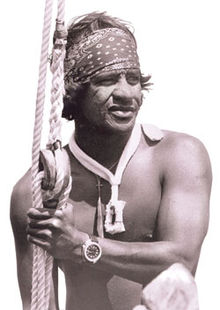My leap into surfing legend and lore started with a bumper sticker. Three words in bold, white print over a black background: Eddie Would Go.
We were driving down from the north shore of Maui, having just visited the dusty lookout over Peahi. The spot is well known to locals and surfers. It’s the perfect vantage point to watch huge waves curl down over intrepid surfers when a swell moves through the area. The nickname for the immense waves (which can exceed 60 feet in height during the winter) is “Jaws.”
Seeing a sticker with Eddie Aikau’s name on it shortly after witnessing the waves in action was fortuitous, though I didn’t realize it until after asking who he was.
“He was a surfer who went on a double-hulled canoe like the old Hawaiians used,” my cousin explained. “The canoe capsized and he tried to paddle back to shore for help, but he died. They hold competitions for him now. You see the stickers all over: ‘Eddie Would Go.’ Because he went out to help people no matter what the conditions were like.”

Eddie was a legend during a time when Hawaiian legends were being resurrected. His generation lived through the turbulent period of Hawaiian history that occurred fewer than 20 years after Hawaii became an American state: the second Hawaiian Renaissance. During that time, native Hawaiians felt more determined than ever to reclaim their heritage. But it also seemed that more impediments than ever stood in their paths. Eddie Aikau–surfer, lifeguard, and ocean lover–helped smooth the tensions between binaries. He wanted everyone to have the same access to sun and surf.
When International Professional Surfing (IPS) was co-founded by Fred Hemmings in 1976, the gnarly waves of Oahu (where Honolulu is located) were surfed mainly by locals and native Hawaiians. But IPS created a circuit of professional surfing competitions. The number of competitions held at the North Shore of Oahu–at popular spots like Pipeline and Sunset–jumped from three to 24 a year. As the number of competitions grew, local surfers were forced to stay away from the waves unless they were registered as competitors and given permits. In response to what was seen as further marginalization of native Hawaiians, a group of 30 surfers formed the Hui ‘O He’e Nalu to protest the professional surfing industry.
Members of the Hui wore black swim shorts with two thin stripes down the outer sides, one yellow and one red. In addition to paddling into the competition zone and riding forbidden waves, some members also got in fights with haole surfers (non-native outsiders). Though they were denounced as “terrorists” by some members of the local media, the Hui helped organize community activities and beach cleanups, and they sponsored young local surfers who didn’t have the money to buy their own boards.
By 1978, the Hui came to a truce with IPS and began working as lifeguards for competitions. Among their ranks was Eddie Aikau, who, as one scholar describes, “became a mediator between haole professional surfers and the Hui.”
* * *
During his nine years as a lifeguard along the North Shore, Eddie attempted more than 500 rescues. Not a single person died on his watch. He was revered, respected, and loved–and his love of surfing 20-to-30-foot waves at Waimea Bay made him fearless. His strength as a surfer and a swimmer earned him a spot on the crew of the Hokule’a.
Hokule’a was a 62-foot double-hull voyaging canoe built in 1975 by a team of scholars, historians, and native Hawaiians. Its architects wanted to prove that early Polynesians were able to cross vast distances repeatedly without the help of metal fittings or navigation aids, like the compass and sextant. No one disputes that there was at least one successful voyage–the linguistic and cultural similarities across multiple islands speak to this. But some scholars found the myths about these voyages too incredible to be true.
But, as this group of latter-day Hawaiian explorers proved, sometimes myths contain more than a grain of truth. “Our success in following traditional sailing directions from Rarotonga to Aotearoa and in repeatedly sailing back and forth over the legendary voyaging track between Hawaii and Tahiti indicates that these and other voyages between distantly separated Polynesian centers were probably well within the capability of Polynesian voyaging canoes and navigation methods,” wrote scholar and participant Ben Finney.
Yet for all their success, the voyages were not without mishap. Paddles snapped, spars were shattered, and the boat capsized in a storm during the 1978 voyage in which Eddie Aikau participated. Although they wrecked 12 miles south of Molokai, Eddie took to his surfboard and attempted to paddle to Lanai for help. The crew was rescued by a U.S. Coast Guard vessel shortly thereafter, but Eddie was never seen again. After the tragedy, the canoe’s navigator, Nainoa Thompson, said, “At a deeper level, Eddie tried to rescue not only the crew of the Hokule’a, but the symbolism and dignity of the canoe, because he knew it carried the pride of his people.”
Weekly Digest
To honor his legacy, Quiksilver created a competition in his memory. Entrants are chosen by members of the Aikau family, and the competition only opens when the waves are perfect. As one organizer describes it: “It has to be big for this thing to run. Really big. Scary big. Sacred big.”
For the first time in six years, the event was to be held at Waimea on February 10, 2016. But on the morning of the competition, the promised swell and huge surf had vanished. The event was cancelled. The waves didn’t live up to Eddie’s legend.







